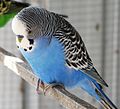Plumage: Difference between revisions
From WikiMD's Wellness Encyclopedia
CSV import |
CSV import |
||
| Line 35: | Line 35: | ||
{{stub}} | {{stub}} | ||
<gallery> | |||
File:Plumage_house_sparrow.jpg|House Sparrow Plumage | |||
File:Guiraca_caeruleaAAP086CB.jpg|Blue Grosbeak Plumage | |||
File:Mandarinducksum.JPG|Mandarin Duck Plumage | |||
File:Blue_male_budgie.jpg|Blue Male Budgie Plumage | |||
File:Snowdrop.penguin.600pix.jpg|Penguin Plumage | |||
File:Albino_crow_and_its_mother.JPG|Albino Crow and Its Mother Plumage | |||
</gallery> | |||
Latest revision as of 10:54, 18 February 2025
Plumage refers to the layer of feathers that cover a bird and the pattern, color, and arrangement of those feathers. The term is derived from the French word for feather, "plume".
Types of Plumage[edit]
There are several types of plumage that vary between species, age, and sex of the bird. These include:
- Juvenile Plumage: This is the first set of feathers that a bird grows after hatching. It is usually dull in color to provide camouflage from predators.
- Basic Plumage: This is the set of feathers that a bird grows after molting its juvenile plumage. It is usually more colorful and detailed than the juvenile plumage.
- Alternate Plumage: This is a set of feathers that some birds grow for the breeding season. It is usually more colorful and detailed than the basic plumage to attract mates.
- Eclipse Plumage: This is a set of feathers that some birds, particularly ducks, grow after the breeding season. It is usually dull in color to provide camouflage.
Molting[edit]
Molting is the process by which birds shed old feathers and grow new ones. This usually happens once or twice a year, depending on the species. The timing and pattern of molting can vary greatly between species.
Function of Plumage[edit]
Plumage serves several functions in birds. These include:
- Thermoregulation: Feathers provide insulation to help birds regulate their body temperature.
- Camouflage: The color and pattern of feathers can help birds blend in with their environment to hide from predators or prey.
- Signaling: The color and pattern of feathers can also be used to signal to other birds. This can be for attracting mates, signaling danger, or establishing territory.
- Flight: Feathers are essential for flight. They provide lift and control for the bird in the air.








